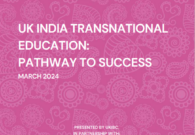UK-India Bilateral Trade Relationship
With PM Modi in the UK this week, there will, no doubt, be speculation about a UK-India trade deal. While there may be such a deal down the line, it won’t happen soon. But that doesn’t mean that businesses cannot grow their exports now. Of course they can.

The UKIBC’s latest report, The UK and India: Bilateral Trade Relationship, shows UK-India trade is growing. Since 2000, it has risen by 300%. UK goods exports have almost doubled, and its services exports have almost quadrupled. At the same time, both Indian goods and services exports to the UK have risen by almost four times.
Direct and visible trade is probably the most cited measure of the two countries’ economic relationship. While important, it is only part of the picture. As two recent UKIBC reports indicate, the bilateral investment and innovation relationships are very strong, strengthening, and vital elements of the UK-India partnership.
All three elements – trade, investment, and innovation collaborations – between the UK and India are on the rise. And macro changes in both countries will spur more positivity. Brexit has meant the UK are looking to strengthen its economic partnerships with India, and Mr Modi’s economic reforms and programmes such as ‘Make in India’ and ‘Digital India’, will lead to more and new forms of economic partnership between India and the UK.
The other factor impacting the India-UK relationship is the massive technological changes taking place across the world and which are impacting every industry.
While the holistic relationship is what matters, this blog will focus on trade and how it will evolve.
Future of UK-India Trade
The specific sectors that are expected to grow in the upcoming years in the UK and India are complementary to each other. New opportunities in emerging technologies will lead to increased trade between the two countries, as they take advantage of each other’s strengths. The UK is poised to become world leaders in AI and other advanced technologies, while India emphasises the need for digitisation and have the goal of becoming a global manufacturing hub.
This is promising for the UK’s advanced manufacturing and machinery sector, as India looks to invest in sophisticated machinery and tools to power their vision of a manufacturing hub. Digitisation means India needs solutions in the digital services sphere that the UK can provide, including in smart cities, Fintech, and cyber security.
This will, in turn, lead to a rise in manufacturing related exports from India to the UK, as India becomes more competitive in areas such as apparel and electronic equipment. And as long as India takes advantage of new emerging technologies, they will continue to be an exceptionally strong IT services exporter, particularly to the UK.
How Governments can spur trade
While some are arguing that a trade deal is the main thing the governments can do, we believe that there are more immediate and highly impactful things that can be done.
First, there is improving the ease of doing business in India. India has already made great strides, leaping from 130 to 100 in the World Bank’s rankings in 2017. This reduces the cost of business for companies in India, making them more efficient and globally competitive. It also makes India a more attractive market for UK businesses. Many UK exporters have concerns about customs procedures in India, so if the Government of India increases the simplicity and speed when it comes to customs procedures, it will spur trade growth.
We are also encouraged by the work started by the governments on the Joint Trade Review (JTR) being undertaken by the two countries, which is examining the non-tariff barriers in key sectors – food and drink, ICT, and life sciences and healthcare – with a view to removing them to increase bilateral trade. Alongside this, the two JETCO Working Groups, looking at infrastruture & smart cities, and advanced manufacturing and technological collaborations, are doing a similar analysis of how to grow UK-India trade.
The goal of the JTR and the JETCO working groups, is to identify quick gains for both countries while laying the foundation for future trade negations.
It is also important for the Governments to provide support to businesses, particularly SMEs, that have got the goods and services that can succeed. There are a small number of excellent “accelerator” programmes, such as the Government of India-backed ‘Access India Programme’ and the DfID-backed ‘Urban Development Gateway Programme’. Both are in their infancy, but are already generating interest from high levels of brilliant SMEs who have great potential, but need some targetted capacity enhancment.
Need for a holistic approach to trade and evaluating trade
But, the best way governments can improve trade linkages is to approach trade in a completely new way. Measuring visible trade is increasingly becoming obscured and in actuality is only a small component of overall economic activity between the two countries. Cross-border supply chains tend to start to blur the overall trade trends and commercial activity picture.
So, when Theresa May and Narendra Modi meet with the UK India CEO Forum on Wednesday, it is right that they celebrate the scale and holistic nature of the existing bilateral relationship. At the same time, it is also right that they focus on how that relationship needs to evolve.







